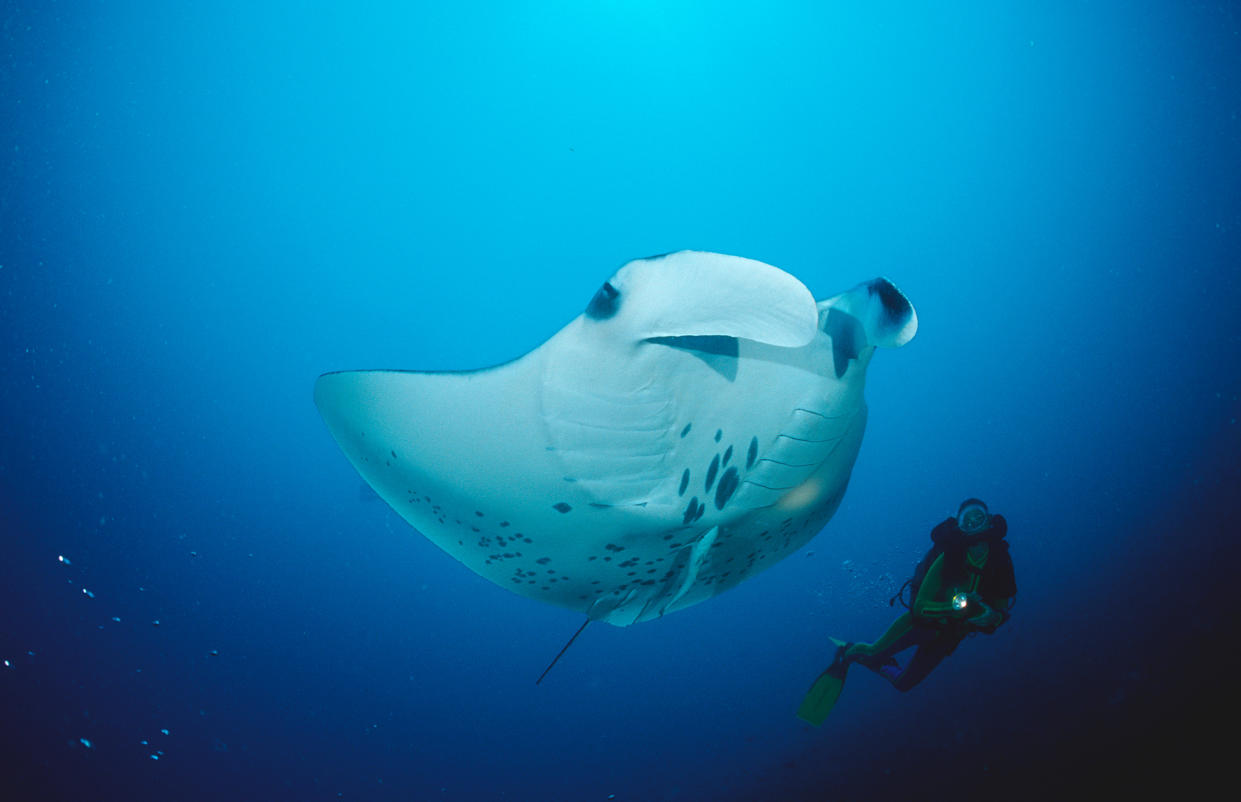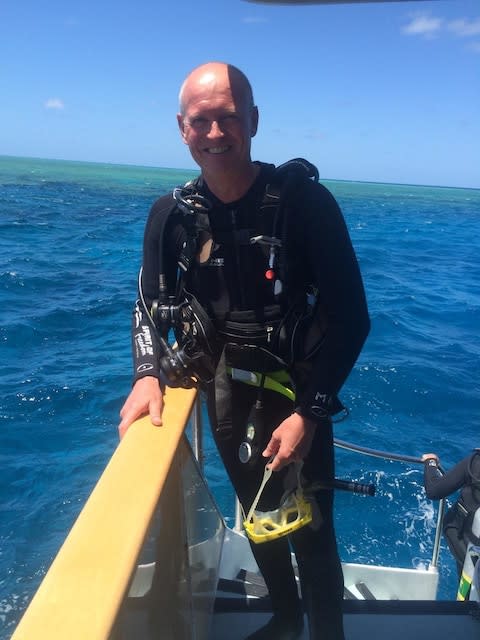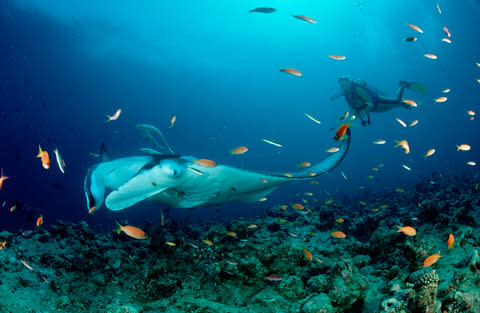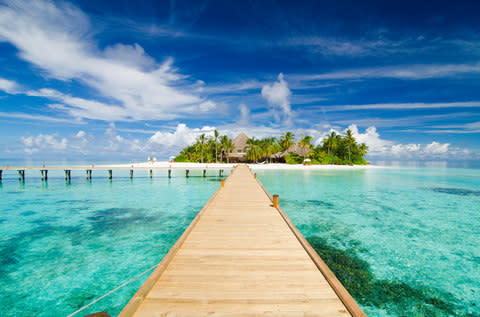My lifelong quest to see a manta ray – and the private island on which it finally ended

“We see manta rays just off the dive centre here in Santa Cruz,” said Pedro Vasconcelos, an underwater photographer in Madeira where these one-ton fish with a 23ft wingspan seem barely to merit a second glance. That was in May 2011, according to my logbook, but after four chilly dives off the Atlantic island (and two more last year) I had failed to see a single one.
I have also failed to see them in Papua New Guinea (near an island called Gonubalabala, where up to 200 gather at one time); at a dozen or so dive sites worldwide called Manta Point or Manta Alley; and at Lighthouse Bommie, on Australia’s Great Barrier Reef where the rays congregate to have parasites removed by fish with strong stomachs.
“They’re here during the spring months, September to November,” the divemaster assured me. I was there in October and saw none.

More galling still, colleagues who dive have come back from Thailand or Indonesia with tales of multiple sightings of these mesmeric creatures, known for their habit of turning graceful somersaults as they feed on plankton. “You should have seen them,” said one fellow journalist, just back from Raja Ampat, almost weeping with nostalgia. “There were seven mantas right under the boat!”
After precisely four decades of diving, “Look, no mantas” had become my mantra – so when the opportunity came to visit the Maldives, where sightings are almost guaranteed, I tried not to dwell on the “almost”. Boning up on the website of the Manta Trust, a global conservation charity, I saw there were an estimated 5,000 reef mantas cruising the atolls all year, of which 2,300 had been individually identified by their markings. This compared with a mere 300 in Hawaii and 500 on the Great Barrier Reef. In addition, perhaps 100 oceanic mantas – bigger and more thrilling -– were known to visit seasonally.
After precisely four decades of diving, 'Look, no mantas' had become my mantra
Near Mirihi Island Resort, where I was going, the critical week is in early December when females begin to arrive for the mating season. This was when I arrived too, touching down in a seaplane as cute as a bath toy on Mirihi’s mirror-calm, pale turquoise lagoon after the 30-minute flight from the capital Malé. “Take off your shoes,” urged Shareef, the general manager, and I buried my feet in the clean, cool, talcum-soft sand. I’d remain barefoot, night and day, until the seaplane returned to collect me.

This was my first trip to the Maldives, and I’d been led to believe that its 120 or so resort islands were anodyne pockets of super-luxury devoid of wildlife. On a brief tour of Mirihi, a private island less than 400yd long and 50yd wide, I found this wasn’t the case. Black bats the size of crows swooped down from the palm trees in broad daylight, screeching loudly at the height of their breeding season. Off the beach, in just a few inches of water, a moray eel snaked its way through the shallows, followed by a pair of baby blacktip reef sharks.
My manta ray quest began the next morning from Handhu – a fibreglass “dhoni” carrying 12 divers – at a dive site called Bobana Thila. There we clung to the reef edge 75ft down as 10 whitetip reef sharks cruised by, followed by muscular tuna and so many turtles I didn’t know where to look. One swam right in-between my dive buddy, Laura, and I; another lingered just 1ft from my mask, a beautiful, calming sight – but still there were no manta rays.
Next we dived at Huru Ali Kandu, where my heart skipped a beat as Hassan, our charismatic dive guide, pointed to an undulating shadow on the fringe of visibility which looked to me like a manta ray. Yes! As it came closer, it turned out to be a mobula ray or “devil fish” – related to the manta, but technically an eagle ray.
In the next few minutes we saw a squadron of three smaller eagle rays glide past, then an electric ray (rare in the Maldives, according to Hassan) and a large, pale-grey lumpen stingray which settled on the seabed and vanished as its camouflage kicked in.

Then, during our surface interval (rest time between dives, allowing surplus nitrogen to leave the bloodstream), Hassan cried out as our boat headed to another reef. “Manta!” There, 20yd away, a flash of white belly indicated that a ray was turning its trademark somersaults at the surface, so we leapt into the water with only masks, snorkels and no wetsuits to take a closer look. Unfazed by our presence, the manta ray carried on feeding then swam slowly away before returning to inspect us, as if it were curious. I could hardly retain my snorkel mouthpiece.
Back on the boat, there was more excitement as a pod of 18ft-long pilot whales escorted us to the next site, Huru Dhoofaru, where we began our dive full of expectation. As we descended to a slope of mostly broken coral, something huge passed over us, blocking out the sunlight. We looked up to see another manta gliding off into the indigo haze. For a full hour we dived with turtles, lobsters, trevally jacks and whitetip reef sharks too numerous to monitor, but there were no more mantas.
On my final day we dived again at Huru Ali Kandu, where the water was eerily calm. So uneventful was the dive, Hassan resorted to taking a golf ball from a pocket in his buoyancy jacket and rolling it along the seabed. A parrotfish, perhaps thinking it was a turtle egg, began to dribble the ball along with its snout in a piscine version of football.
Just then, Hassan looked up, grunted through his mouthpiece and pointed behind me. Spinning round, I saw the beady eye and horn-shaped cephalic fin of a female manta ray less than 3ft from my shoulder. She swam gracefully away and came back for a second pass.
Finding a handhold in the broken coral, we lay as still as we could while a second manta swam in from the deep and passed right over us. I could almost have stroked its snow-white belly. Then suddenly there were four, the largest with a wingspan of 13ft, swooping just inches above our heads like giant bats and returning time and again, as if enjoying the sensation on their skin of our billowing exhaust bubbles.
The effect was meditational as the rays continued their balletic movements. With a jolt, I remembered my air supply and looked at my gauge – but with my breathing slowed, and at a fairly shallow depth, I had used up less air than I expected.
Exchanging hand signals, we called it a day and ascended slowly to Twister, the traditional wooden dhoni used for most of the diving at Mirihi Island. I looked at my wrist computer and was staggered to find that I had been down for 1 hour and 12 minutes – my longest ever dive. In the company of those astonishing, long-awaited giants, time really had stood still.
The essentials
Hayes & Jarvis (01293 762456; hayesandjarvis.co.uk) is offering a seven-night holiday to the Maldives, staying at the five-star Mirihi Island Resort on a B&B basis, from £3,246 per person – saving up to £434 per person. The offer includes seaplane transfers and return international flights from London Gatwick with British Airways, and is based on a departure date of November 1 2017. Diving costs extra. Book direct at hayesandjarvis.co.uk/holidays/maldives/hotels/mirihi
The world's best dive sites